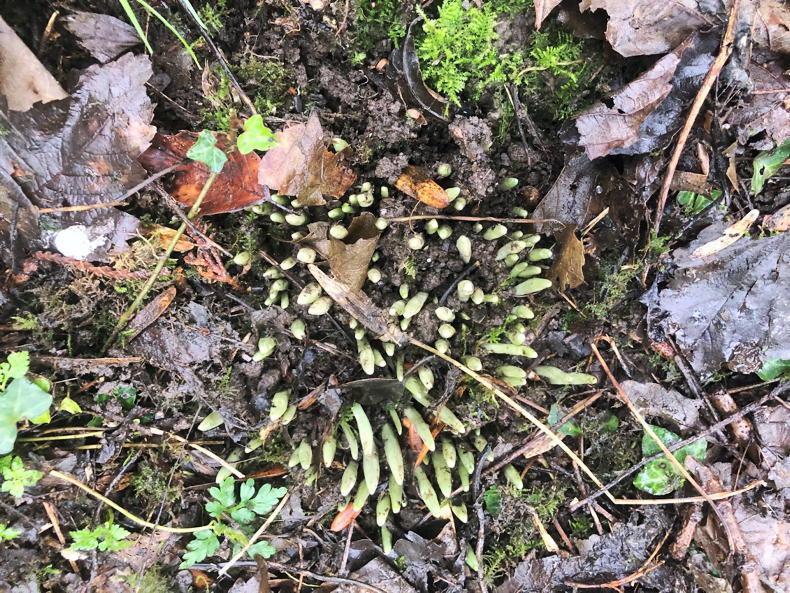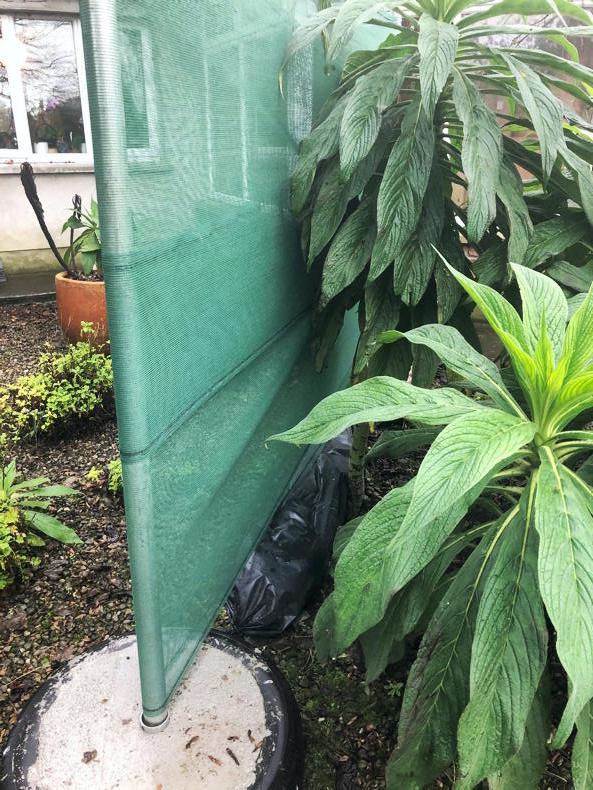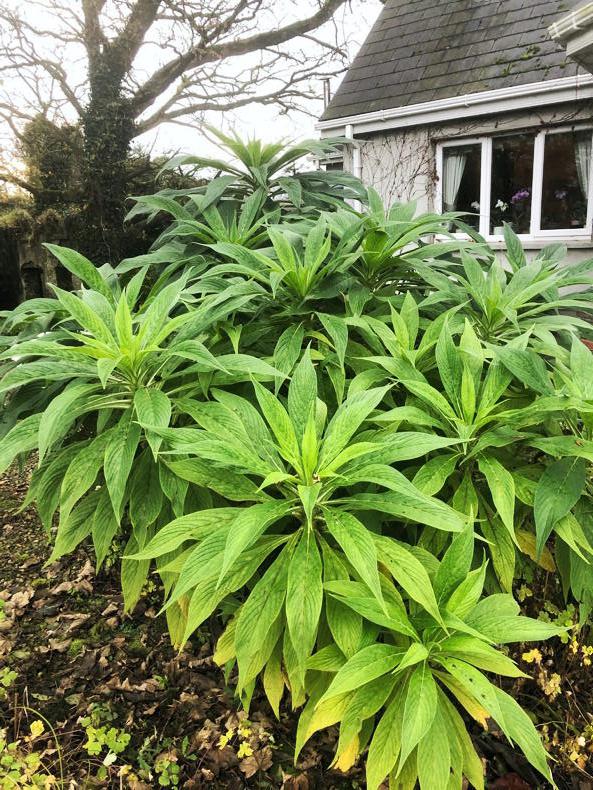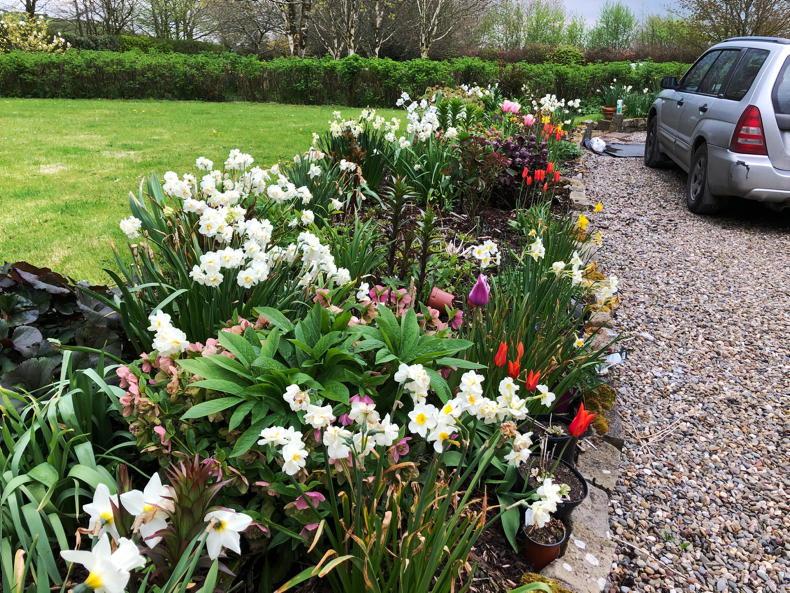When I last talked to you about the garden I had three big jobs to complete: plant alliums, move peonies and protect the echiums from frost. I didn’t get all the jobs done but as Meat Loaf used to sing Two out of three ain’t bad.
Getting the alliums planted was simple enough and I managed to do it without slicing through existing bulbs with the spade. Last year I wanted to plant a wildflower meadow in the orchard but instead of sowing a seed mix I planted a bag of 100 mixed alliums.

Baby snowdrops making their appearance
They turned out lovely so I added to their number this year. I planted mainly ‘Purple sensation’ and the ‘Drumstick’ alliums as they both stand tall of the grass, keep their colour for weeks and maintain their shape and form for ages.
Echium protection
I can only claim ‘back seat driver’ input to the protection of our stand of echiums. Growing echiums is a bit like growing a hay meadow. You do everything right and just when you are ready to bale, a grey mist rolls in from the west and that’s the end of your crisp crop of hay.

Potecting echiums from the frost.
Ehiums are self seeders and are happiest growing where their seed lands. In our garden that meant east facing with the risk of severe frost while also being in the path of the prevailing westerly gales.
The thing about echiums is that you have to get them through two winters before they produce a magnificent column of blue or pink flowers. They are not frost hardy and so you could lose them right up to a month before they flower at the end of May. So how do you protect them from frost?
Sean got three old tyres and filled them with cement leaving a space for an upright metal tube in the middle. When the cement set we were able to roll them into place, insert the metal tubes and fix six foot high green mesh to the poles. The stand of echiums are now protected on three sides and in the event of a heavy frost I can cover the unprotected side with some fleece.

Minding my echiums from the frost.
As well as that bunch we have a dozen more that stand alone and apart from some fleece I’m afraid they will have to take their chances with the winter weather. If they all survive it will be a sight for sore eyes.
Looking forward
I never got a chance to move the peonies but after much prevarication I now know where to plant them. My happiest distraction for the next while will be the snowdrops. The little dotes don’t give a hoot about the weather. They are well up already and with them comes all our hopes for renewal and a happy and healthy 2021 to all our readers from me.

Spring bulbs - something to look forward to.
Move pelargoniums, osteospermum and dahlias in-doors if you live in an area liable to hard frost.Tidy away weeds from your snowdropsDon’t ignore unplanted spring bulbs. Get them in the ground now.Many people rediscovered their gardens during COVID-19, so why not go one step further and plant a small orchard.
I‘m thinking of planting a few fruit trees so I turned to Patrick and Tom English for advice. I came away from our chat convinced that what both men know about fruit trees could fill an encyclopaedia. Starting in 1947 three generations of the English family have worked in the fruit nursery business at Adamstown, Co Wexford. And it’s a business they are passionate about.
Patrick tells me the apples we buy in the supermarkets are usually harvested well before they are ripe. However, if you grow your own apples you can ripen and store them properly to get the best value from their nutrients.
He says that over the years our taste in apples has changed. We now like them sweeter, hence the success of ‘Pink Lady’. “I’d have to say some varieties of ‘Cox’s Pippen’ have never been equalled for taste. However, they are not great to grow here as they can be a bit hard and not very vigorous.”
A good site
If you are planning to set a fruit orchard Patrick advises to select a site carefully. “You need good shelter and sunshine. Not too much shelter mind, as you need the air to circulate to lessen disease. Watch that the sun doesn’t catch the apples in the early morning when there’s a chance of frost. We’d expect to be safe from frost by 12 May but last year we had frost on 14/15 May and it did a lot of damage,” he says.
Planting time
Modern fruit trees are smaller than in the past and easier to work with. They like free-draining soil so make sure the planting hole is not waterlogged. If the ground is very damp then dig the hole a bit deeper and fill with stone or gravel making sure there is an outlet to drain away excess water.
There’s an old saying that the best time to plant fruit trees is when there is an R in the month. Patrick’s advice is to get them in the ground by 17 March. There’s no need for a big planting hole – six to eight inches is fine. Make sure you don’t plant any deeper than the soil mark on the stem.
Lots of variety
When it comes to cooking apples ‘Bramleys’ remain the most popular while ‘Jonagold’ is great for juice says Tom.
“‘Boskoop’ is a sweeter cooking apple and is also good as a pollinator. ‘Grenadier’ and ‘Howgate Wonder’ are a good choice and are found in most old orchards while ‘Charles Ross’ is a popular cooker and eater.”
Two good varieties that have stood the test of time are ‘Katy’ an early apple that ripens in August and ‘Discovery’ which ripens in September. “This is a beautiful Irish apple and one that appeals to our taste buds. ‘Lord Lambourne’ is another good storage variety with disease resistance, says Tom.
For older people who want to get the taste of their childhood he’d recommend ‘Beauty of Bath’ and ‘Worcester Pearmain’.
Pears and plums
As to pears Tom says you can’t beat the ‘Conference’ a self-fertile tree that will pollinate all pear trees. Today’s varieties ripen better than those of the past. ‘Victoria’ plums also self-pollinate but do better with a partner.
Thanks to Patrick and Tom English for their advice. You can visit their nursery at Adamstown Co Wexford Y21RY64 or call 053-924 0984 or info@englishesfruitnursery.ie. Their website is a mind of information on all the fruit trees they stock.
When I last talked to you about the garden I had three big jobs to complete: plant alliums, move peonies and protect the echiums from frost. I didn’t get all the jobs done but as Meat Loaf used to sing Two out of three ain’t bad.
Getting the alliums planted was simple enough and I managed to do it without slicing through existing bulbs with the spade. Last year I wanted to plant a wildflower meadow in the orchard but instead of sowing a seed mix I planted a bag of 100 mixed alliums.

Baby snowdrops making their appearance
They turned out lovely so I added to their number this year. I planted mainly ‘Purple sensation’ and the ‘Drumstick’ alliums as they both stand tall of the grass, keep their colour for weeks and maintain their shape and form for ages.
Echium protection
I can only claim ‘back seat driver’ input to the protection of our stand of echiums. Growing echiums is a bit like growing a hay meadow. You do everything right and just when you are ready to bale, a grey mist rolls in from the west and that’s the end of your crisp crop of hay.

Potecting echiums from the frost.
Ehiums are self seeders and are happiest growing where their seed lands. In our garden that meant east facing with the risk of severe frost while also being in the path of the prevailing westerly gales.
The thing about echiums is that you have to get them through two winters before they produce a magnificent column of blue or pink flowers. They are not frost hardy and so you could lose them right up to a month before they flower at the end of May. So how do you protect them from frost?
Sean got three old tyres and filled them with cement leaving a space for an upright metal tube in the middle. When the cement set we were able to roll them into place, insert the metal tubes and fix six foot high green mesh to the poles. The stand of echiums are now protected on three sides and in the event of a heavy frost I can cover the unprotected side with some fleece.

Minding my echiums from the frost.
As well as that bunch we have a dozen more that stand alone and apart from some fleece I’m afraid they will have to take their chances with the winter weather. If they all survive it will be a sight for sore eyes.
Looking forward
I never got a chance to move the peonies but after much prevarication I now know where to plant them. My happiest distraction for the next while will be the snowdrops. The little dotes don’t give a hoot about the weather. They are well up already and with them comes all our hopes for renewal and a happy and healthy 2021 to all our readers from me.

Spring bulbs - something to look forward to.
Move pelargoniums, osteospermum and dahlias in-doors if you live in an area liable to hard frost.Tidy away weeds from your snowdropsDon’t ignore unplanted spring bulbs. Get them in the ground now.Many people rediscovered their gardens during COVID-19, so why not go one step further and plant a small orchard.
I‘m thinking of planting a few fruit trees so I turned to Patrick and Tom English for advice. I came away from our chat convinced that what both men know about fruit trees could fill an encyclopaedia. Starting in 1947 three generations of the English family have worked in the fruit nursery business at Adamstown, Co Wexford. And it’s a business they are passionate about.
Patrick tells me the apples we buy in the supermarkets are usually harvested well before they are ripe. However, if you grow your own apples you can ripen and store them properly to get the best value from their nutrients.
He says that over the years our taste in apples has changed. We now like them sweeter, hence the success of ‘Pink Lady’. “I’d have to say some varieties of ‘Cox’s Pippen’ have never been equalled for taste. However, they are not great to grow here as they can be a bit hard and not very vigorous.”
A good site
If you are planning to set a fruit orchard Patrick advises to select a site carefully. “You need good shelter and sunshine. Not too much shelter mind, as you need the air to circulate to lessen disease. Watch that the sun doesn’t catch the apples in the early morning when there’s a chance of frost. We’d expect to be safe from frost by 12 May but last year we had frost on 14/15 May and it did a lot of damage,” he says.
Planting time
Modern fruit trees are smaller than in the past and easier to work with. They like free-draining soil so make sure the planting hole is not waterlogged. If the ground is very damp then dig the hole a bit deeper and fill with stone or gravel making sure there is an outlet to drain away excess water.
There’s an old saying that the best time to plant fruit trees is when there is an R in the month. Patrick’s advice is to get them in the ground by 17 March. There’s no need for a big planting hole – six to eight inches is fine. Make sure you don’t plant any deeper than the soil mark on the stem.
Lots of variety
When it comes to cooking apples ‘Bramleys’ remain the most popular while ‘Jonagold’ is great for juice says Tom.
“‘Boskoop’ is a sweeter cooking apple and is also good as a pollinator. ‘Grenadier’ and ‘Howgate Wonder’ are a good choice and are found in most old orchards while ‘Charles Ross’ is a popular cooker and eater.”
Two good varieties that have stood the test of time are ‘Katy’ an early apple that ripens in August and ‘Discovery’ which ripens in September. “This is a beautiful Irish apple and one that appeals to our taste buds. ‘Lord Lambourne’ is another good storage variety with disease resistance, says Tom.
For older people who want to get the taste of their childhood he’d recommend ‘Beauty of Bath’ and ‘Worcester Pearmain’.
Pears and plums
As to pears Tom says you can’t beat the ‘Conference’ a self-fertile tree that will pollinate all pear trees. Today’s varieties ripen better than those of the past. ‘Victoria’ plums also self-pollinate but do better with a partner.
Thanks to Patrick and Tom English for their advice. You can visit their nursery at Adamstown Co Wexford Y21RY64 or call 053-924 0984 or info@englishesfruitnursery.ie. Their website is a mind of information on all the fruit trees they stock.











 This is a subscriber-only article
This is a subscriber-only article










SHARING OPTIONS: